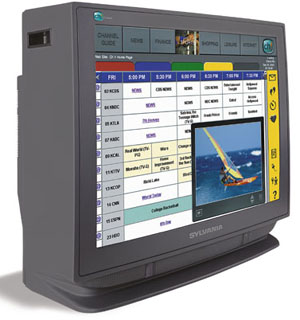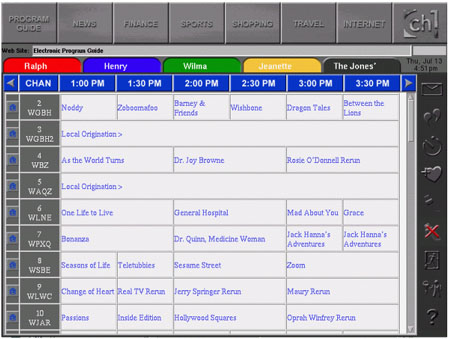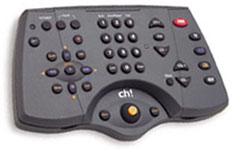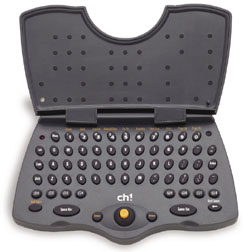Article: New Sylvania Internet/TV has “Linux inside”
Mar 8, 2001 — by Rick Lehrbaum — from the LinuxDevices Archive — 9 viewsThis Summer, Sylvania Computer Products will introduce a new 27-inch digital TV that combines the functions of a TV with those of an Internet appliance. The device, which owes its internal intelligence to a single-chip PC (a National Semiconductor Geode) running an

Sylvania's new Internet/TV with “Linux inside”
The new Sylvania Model SPC2700iHD Internet/TV is the product of a collaboration with Ch.1 Inc. (Santa Ana, CA), a company which has developed an embeddable Internet appliance subsystem for next generation digital TVs. Ch.1 plans to license this technology, known as the “Ch.1 Platform,” to as many TV manufacturers as possible. Similar products are expected to be introduced, also in the Summer 2001 timeframe, by both Panasonic and Zenith.
Basically, the Ch.1 Platform consists of . . .
- A high resolution HDTV-ready monitor with a built-in conventional TV tuner
- An embedded Internet appliance computer that supports both dialup (56K) and broadband (Ethernet) Internet access
- Sophisticated Linux-based operating system and user interface software, with an easy-to-use graphical interface that unifies TV watching and Internet viewing
- A combination remote/keyboard/mouse to simplify system operation
- Internet-based control and database services (the “Ch.1 network”)
The new Sylvania Internet/TV receives standard broadcast or cable TV signals via a built-in TV tuner and is usable as a high resolution display for external video sources including VCRs, DVD players, DSS, cable boxes, and computers (up to 800 x 600 SVGA resolution). The system is also “HDTV-ready,” which means it will be able to display the high bandwidth video signals produced by an external HDTV receiver. In the mean time, a unique “line-doubler” technology provides higher-than-normal resolution display from standard TV signal sources on the set's high quality monitor, by displaying all horizontal scan lines simultaneously instead of in the interlaced manner of ordinary TVs.
Using the Internet/TV's Ch.1-enabled functions, you can watch TV, browse the Internet, create web and TV “favorites,” view a customized programming guide, access preprogrammed category portals, send email, chat, shop, and listen to MP3s. You can also watch a TV program while simultaneously interacting with its associated website using the set's “Picture-in-Portal” technology, or direct your VCR (or HDR) when and what to record through Ch.1's web-based control screen. Onscreen buttons give you easy access to the Internet/TV's user manual, product or accessory upgrades, customer service, and technical support.
Notably, unlike solutions based on adding an Internet access set-top box to a conventional TV, the Sylvania Internet/TV let's you browse the web with full 800 x 600 SVGA resolution. And if you want the comfort of typing with a full-size keyboard, you can easily add one as an optional accessory. So, this device may just be the ticket to Internet access for the roughly 50 percent of consumers that don't already own a PC.
How does it work?
The Internet/TV combines TV functions, much like those of a normal TV, with computer functions, similar to those of a desktop PC. Unlike a normal TV, however, you connect it to both a TV source (antenna, cable, satellite) and an Internet source (dial up, broadband). Then, you subscribe to Ch.1's service through online registration (and automatic credit card payment), which enables the TV's Internet features. The set now automatically seeks online connection with the Ch.1 network. Once Ch.1's servers validate the TV set as a registered subscriber, it's ready for use as an Internet/TV.
From now on, when you tune your Internet/TV to channel 1, you view the special “Ch.1 network screen,” which serves as a graphical interface to the set's Internet and other advanced features. This screen contains an interactive channel guide, and also serves as the interactive display for use with the system's many-function remote control.

The Ch.1 Graphical User Interface
The Ch.1 user interface is a combination TV-control and web-browsing interface that is intended to make navigating Internet websites and changing TV channels equally easy.
Along the top of the screen are a series of “portal buttons” for channel guide, news, finance, sports, shopping, leisure, Internet, etc. Below that is a set of colored tabs, which are used to define up to five system users — resulting in customized settings and links for various household members. Within the content of the screen (in this case, a sample channel guide) are links to the TV stations' websites, making it convenient to access online content while viewing TV programs. Finally, in the vertical bar along the right of the screen are a set of icons for popular operations like email, auto-tune, auto-record, website favorites, help, and more.
Getting remote
Another important part of the Internet/TV system is the special Ch.1 remote control, which includes TV control buttons, an alphanumeric keyboard, and mouse functions.


The Ch.1 remote control
With many of its embedded Internet appliance features defined by reprogrammable software rather than permanent hardware, the Sylvania Internet/TV can easily be upgraded via software downloads to add new features or fix bugs. The Ch.1 Internet service provides such updates automatically during “off” hours, while the TV set is not in use.
Linux inside
As mentioned, the built-in Internet appliance capabilities of Sylvania's Internet/TV derive from an internal “embedded” computer which bears a high resemblance, at least electronically, to an ordinary desktop PC. The CPU is a 266MHz National Semiconductor Geode, which is compatible with Intel Pentium's “x86 architecture.” As for memory, there are 64MB of RAM in which to run programs — much the same as within most of today's desktop PCs.
When it came to deciding what sort of disk drive to use, cost and reliability concerns dictated the use of a solid-state storage device, rather than a conventional (rotating magnetic media) hard disk. To this end, Sylvania's Internet/TV contains a 16MB nonvolatile “Flash” memory device called a DiskOnChip. The Ch.1 Platform also supports an internal hard disk option, presumably to add the feature of video recording and storage.
Having the right connections
In light of all the capabilities offered by Sylvania's Internet/TV, it should come as no surprise that the system has a dizzying number of external interface connectors. These include . . .
- IR Receiver for interfacing remote/keyboard/mouse device
- IR Blaster for interfacing with a variety of external devices
- Two USB ports
- Fast Ethernet (10/100 mbps) broadband interface (RJ45 connector)
- 56K V90 modem phone line interface (RJ11 connector)
- Composite video inputs/outputs, with L/R audio (RCA jacks)
- S-video input, with L/R audio
- High resolution RGB video (RGBHV) input, for either HDTV (480p and 1080i formats) or computer-generated SVGA video input (DB15 connector)

No shortage of input/output connections here!
Why Linux?
Why did Ch.1 pick Linux to be the software basis of their embedded Internet appliance technology? According to Rey Roque, Ch.1's vice president in charge of development, some of the key reasons for selecting Linux were that its per-unit cost is less than with any other operating system, its strong support for Internet access functions, the fact that multimedia plug-ins are readily available, and . . . frankly, his customers wanted it. Roque also mentioned that although Ch.1's policy is to be agnostic with respect to operating systems, open source software (like Linux) has the advantage of “greater robustness due to continuous testing by a large population of developers,” plus “greater design flexibility due to availability of the source code.”
Indeed, that sentiment is echoed by Sylvania's director of sales, Stephen Alvarez, who says Sylvania chose to integrate Ch.1's Internet appliance platform “due to their high resolution display, beautifully implemented remote keyboard, x86 (Intel compatible) architecture, and stable Linux-based operating system.”
When can I get one? . . . How much will it cost?
Sylvania's first HDTV-ready Internet/TV will be a 27-inch model with a 4:3 CRT. It's expected to be available through retail channels this summer, at a suggested list price of $899.
Ch.1's network services and localized interactive channel guide will be available to consumers starting at $8.95 per month. Subscribers can use their existing ISP, or they can obtain ISP services along with the Ch.1 network services for an added cost of approximately $10 per month.
This article was originally published on LinuxDevices.com and has been donated to the open source community by QuinStreet Inc. Please visit LinuxToday.com for up-to-date news and articles about Linux and open source.